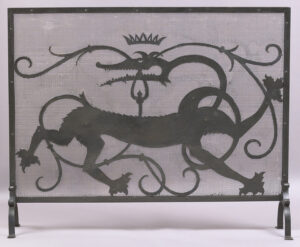
Wilhelm Hunt Diederich
American, born Hungary 1884–1953
Salamander King Fire Screen, ca. 1924–1930
Wrought iron, sheet iron, woven wire mesh and rivets
Purchase: Gift of Estelle Reninger, 2005. (2005.3.1)
Case 1: Material Explorations
Tiffany Studios
American, 1902–1932
Lent by an anonymous collector
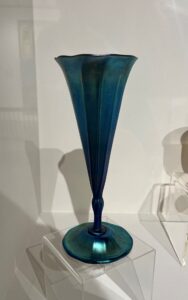
Right to left:
Trumpet vase, ca. 1910
Blue Favrile glass
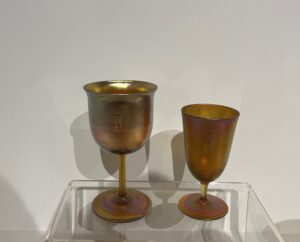
Goblet and Short-stemmed water goblet in “Prince” pattern, ca. 1910
Gold Favrile glass

Saucer in “Prince” pattern,
1910
Gold Favrile glass

Two sherbet dishes in “Prince” pattern, ca. 1910
Gold Favrile glass

Three cordial glasses in “Prince” pattern, ca. 1910
Gold Favrile glass

Two champagne glasses in “Manhattan” pattern, ca. 1910
Gold Favrile glass
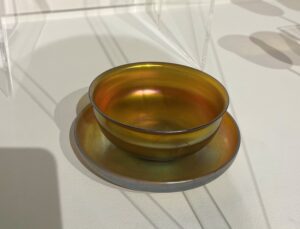
Finger bowl and Saucer in “Prince” pattern, c. 1910
Gold Favrile glass

Two long-stemmed wine glasses in “Prince” pattern, ca. 1910
Gold Favrile glass
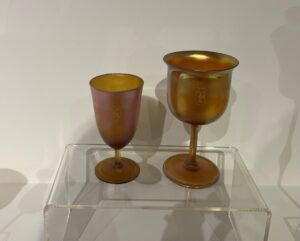
Short-stemmed water goblet and Goblet in “Prince” pattern,
1910
Gold Favrile glass

Finger bowl and Saucer in “Prince” pattern, ca. 1910
Gold Favrile glass
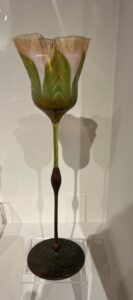
Floriform Vase with Metal Stem, ca. 1900–1902
Hand-blown Favrile glass and patinated bronze
Case 2: Tiffany Glass
Louis Comfort Tiffany’s experiments in glassblowing led to the production of his distinctive “Favrile glass,” named after the Old English word fabrile, meaning handwrought. At his Tiffany Studios in Corona, Queens, artisans worked with opalescent glass, infusing their objects with color and textural effects during the process. This was atypical for the time, when it was more common to work with consistent and translucent pot glass, which might be painted later for effect. Favrile glass is distinguished by its delicacy and endless variety as well as its potential to approximate the iridescence of ancient glass.
Right:
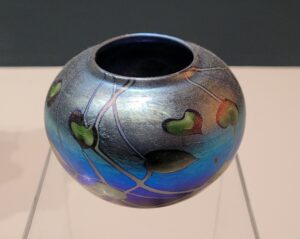
Tiffany Studios
New York, NY, 1902–1938
Miniature Favrile Vase with Leaves, ca. 1910
Favrile glass
Gift of Remo and Verna Canova, 1997. (1997.3.4)

Wine Goblet, ca. 1900
Favrile glass
Gift of Remo and Verna Canova, 1997. (1997.3.8)

Louis Comfort Tiffany
American, 1848–1933
Letter Seal
Glass
Gift of the Reverend and Mrs. Van S.
Merle-Smith, Jr., 1995. (1995.16.2)

Tiffany & Company
New York, NY, 1837 to present
Condiment Jar, ca. 1907–1910
Favrile glass and sterling silver
Purchase: Gift of Edith M. Merkle in Memory of Dr. Ralph Merkle, 1994. (1994.8)
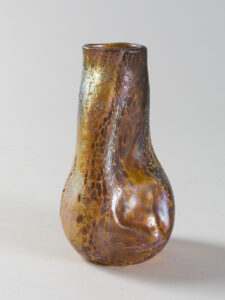
Louis Comfort Tiffany
American, 1848–1933
Cypriote Vase, ca. 1896
Favrile glass
Gift from the Lloyd and Barbara Macklowe Tiffany Glass Collection. (2019.24)
This vase was made soon after Tiffany developed a new style of glass he called Cypriote, which imitated the pitted, iridescent surface of ancient glass excavated in Cyprus. To achieve a similar effect, Tiffany’s glassblowers applied potassium nitrate to their glass: when heated, it created bubbles that dimpled the surface of the finished vessel. After the glass blowing was complete, they would expose the vase to metallic salt fumes that oxidized into an iridescent sheen. Tiffany welcomed irregularities like the odd shape of this vase as part of the artistic process.
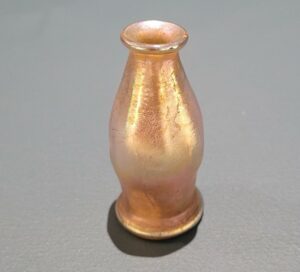
Tiffany Studios
New York, NY, 1902–1938
Bottle (Phoenician Style), early 1900s
Iridescent glass
Gift of the Reverend and Mrs. Van S. Merle‑Smith Jr., 1978. (1978.34.35)
Center:
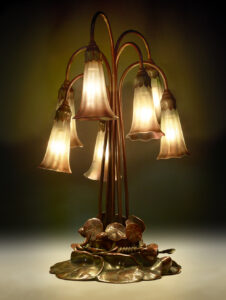
Tiffany Studios
New York, NY, 1902–1938
Emarel Freshel, designer
American, 1867–1949
Seven-Light Lily Lamp, ca. 1902
Favrile glass and patinated bronze base
Gift of Remo and Verna Canova, and of Christine I. Oaklander in honor of her mentor Mary Alice Mackay; by exchange, 2016. (2016.30.)
Inspired by nature, Tiffany’s lily lamp is a useful object transformed into a thing of beauty. Though its form is a hybrid of water lily pads at the base with long-stemmed, nodding field lilies above, its naturalism and elegance is convincing. Each handblown favrile glass shade is as unique as an organic bloom. While the lily lamp remained in production into the 1920s, this lamp’s thinner stems and slightly shorter height identify it as early. It was the advent of electricity, in only two percent of American homes at the time, that allowed for the production of a working lamp in such a delicate form.
Left:

Favrile Glass Footed Bulbous Vase, ca. 1905
Favrile glass
Gift of Remo and Verna Canova, 1997. (1997.3.13)
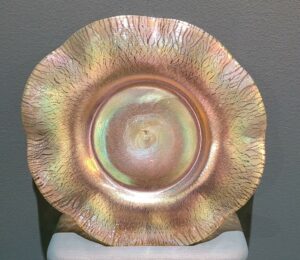
Favrile Glass Plate, ca. 1905
Favrile glass
Gift of Remo and Verna Canova, 1997. (1997.3.11)
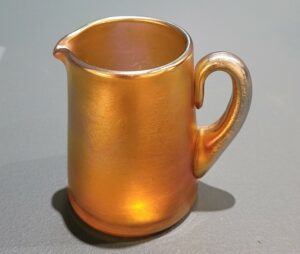
Cream Pitcher, ca. 1910
Favrile glass
Gift of Remo and Verna Canova, 1997. (1997.3.3)
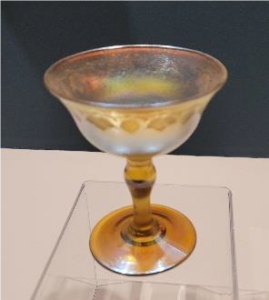
Wine Glass, ca. 1900
Favrile glass
Gift of Remo and Verna Canova, 1997. (1997.3.14)
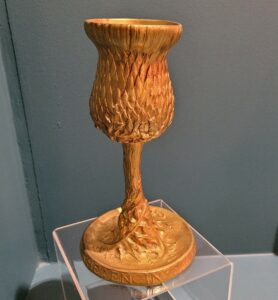
Tiffany Studios
New York, NY, 1902–1938
Goblet, 1907
Gilding on bronze
Purchase: Gift of Edith M. Merkle in Memory of Dr. Ralph Merkle, 1993. (1993.24)

Wharton Esherick
American, 1887‑1970
Wagon Wheel Chair, 1932
Hickory and leather
Purchase: Gift of Edith M. Merkle in memory of Dr. Ralph Merkle, 1997. (1997.18)
Case 3: The Arts and Crafts Movement
From the late 1800s through the 1920s, artists reacted to industrialization with renewed interest in the handmade. Spreading from Britain to America, the Arts and Crafts movement focused on beautiful and simple design for the home. Their respect for natural forms and materials parallels the harmonious design of Frank Lloyd Wright’s Little Library, on display at left.
Wallpaper: reproduction of The Stag, an 1896 design by C. F. A. Voysey (British, 1857–1941)
Right to left:

Liberty & Co.
Birmingham, England, 1874–present
Round Box, 1899
Silver with enamel decoration
Purchase: The Gift of John and Fannie Saeger, 2005. (2005.28 a, b)

Frederick Carder, designer
American, born England, 1863–1963
Steuben Glass Works, manufacturer
Corning, NY, 1903–2011
Stemmed Vase, ca. 1905
Blue Aurene iridescent glass
Gift of Remo and Verna Canova, 2004. (2004.1.1)
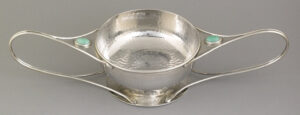
Charles Robert Ashbee, designer
British, 1863–1942
Shreve, Crump & Low Co., manufacturer
Boston, MA, 1869–present
Two Handled Dish, ca. 1902–1914
Sterling silver with cabochon-jade insets
Purchase: Gift of Edith M. Merkle in Memory of Dr. Ralph Merkle, 1993. (1993.2)
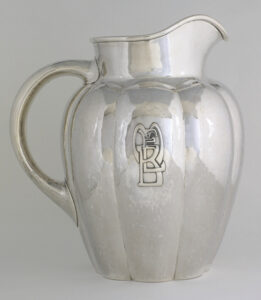
Clara Barck Welles, designer
American, 1868–1965
Kalo Shop
Chicago, IL, 1900–1970
Pitcher, ca. 1905–1914
Silver
Purchase: Gift of Edith M. Merkle in Memory of Dr. Ralph Merkle, 1992. (1992.24)
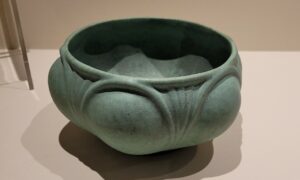
Hugh Mackie Gordon Garden, designer
Canadian, 1873–1961
American Terra Cotta & Ceramic Co., manufacturer
Crystal Lake, IL, 1881–present
Teco Pottery Jardinere, 1904–1920
Terracotta with green matte glaze
Gift of David A. Hanks, 1976. (1976.33)

William De Morgan
British, 1839–1917
Charger, ca. 1880s
Earthenware with luster decoration
Purchase: The Gift of John and Fannie Saeger, 2004. (2004.17)
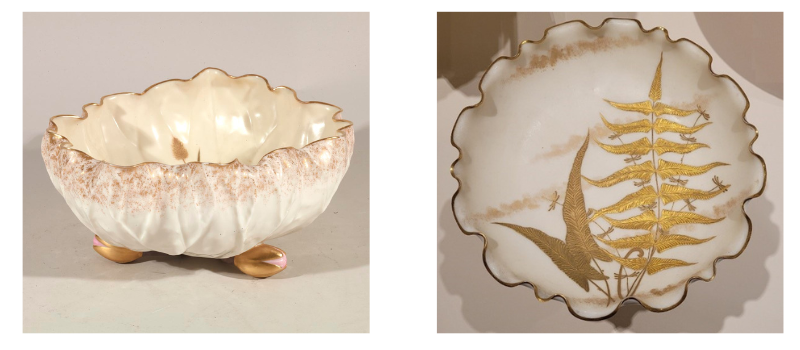
Ott & Brewer
Trenton, New Jersey, 1871–1893
Bowl, ca. 1882–1892
Compote, ca. 1880s
Porcelain
Gift of Thomas C. Folk, 2001. (2001.15.1, 2)
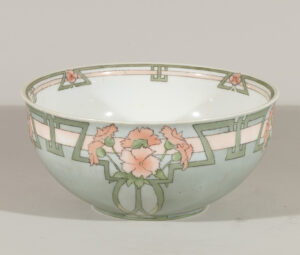

Edith Kredell
American, active early 1900s
Salad Bowl, 1911
Plate, 1911
Painted porcelain
Gift of Peggy Rice in Memory of Anna Wood Prutzman, 1988. (1989.2.1, 2)

Chikayoshi Gokyoro
Japanese, active ca. 1865–1890
Summer, 1865
Woodblock print mounted on silk brocade, with silk brocade with metal-wrapped thread

Winter, 1865
Woodblock print mounted on silk brocade with embroidery in silk and metal-wrapped thread, with silk brocade with metal-wrapped thread
Publisher: Yamashiroya Jinbei, Tokyo, Japan
Gift of Kate Fowler Merle‑Smith, 1976.
(1976.20.138–139)
This pair of woodblock prints are presented as hanging scrolls, mounted on sumptuous silk brocade usually reserved for painted works. Scrolls like these would be displayed in an alcove in a traditional Japanese house and often switched out from season to season.
Beginning in the mid-nineteenth century, Japanese woodblock prints were enthusiastically collected in the West. Like other forms of Japanese art, they influenced American artists of the late nineteenth and early twentieth centuries, including architect Frank Lloyd Wright, who designed the 1912-15 library to your right. The Merle-Smith family likely acquired these scrolls on a trip to Asia in the early twentieth century.

Utagawa Kunimaru
Japanese, 1793–1829
The Origin of the Maru-Ebiya House, 1820s
Woodblock print mounted on silk brocade, with silk brocade with metal-wrapped thread
Gift of Kate Fowler Merle‑Smith, 1976. (1976.20.133)

Kikugawa Eizan
Japanese, 1787–1867
Komurasaki and Gompachi, ca. 1821
Woodblock print mounted on silk brocade, with silk brocade with metal-wrapped thread
Gift of Kate Fowler Merle‑Smith, 1976. (1976.20.128)

